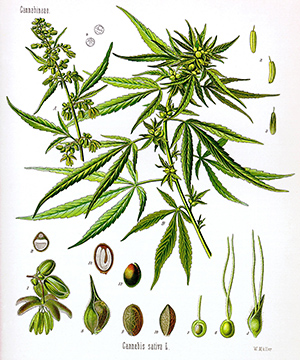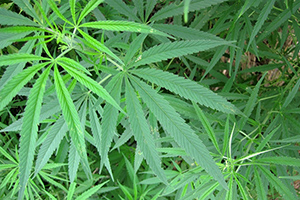The Cannabis Plant
Technically and legally, regardless of origin, all cannabis plants are classified as Cannabis Sativa. The strains can be further classified as ‘C. sativa var. sativa’, ‘C. sativa var. indica’, ‘C. sativa var. afghanica’, and ‘C. sativa var. ruderalis’. For our purposes we will only be covering the sativa and indica plants as the majority of strains available for cultivation are one of these two variants, or are hybrids containing genetics from these two. Each of these plants have distinctive growth patterns, physical appearances, smells, tastes, effects, etc.
Cannabis origins are clouded by the plant’s early symbiotic relationship with humans. It has been grown for 3 products: the seeds, which are used as a grain like food and animal feed and for oil; it’s fiber, which is used for cloth and rope; and its resin, which is used medically and recreationally since it contains the group of psychoactive substances collectively known as tetra-hydrocannibinol, usually referred to as THC. Plants grown for seed or fiber are usually referred to as hemp and contain small amounts of THC. Plants grown for THC and for the resin are referred to as marijuana.
Use of cannabis and its products spread quickly throughout the worls. Marijuana is now cultivated in climates ranging from the arctic to the equator. Cannabis has been evolving for hundreds of thousands of generations on its own and through informal breeding programs by farmers. A diverse group of varieties has evolved or been developed as a result of breeders attempts to create a plant that is efficient at producing the desired product, which flourishes under particular environmental conditions.
Varieties differ in growth characteristics such as height, width, branching traits, leaf size, leaf shape, flowering time, yield, potency, taste, type of high, and aroma. For the most part, potency is a factor of genetics. Some plants have a genetic potential of producing high grade marijuana and others do not. The goal of the cultivator is to allow the high THC plants to reach their full potential.
Cannabis is a fast growing dioecious (male and female) annual plant. It does best in a well drained medium that is high in fertility. It requires long periods of unobstructed bright light daily. In nature, cannabis annual cycle begins with germination in the early spring. The plant grows vigorously for several months and then begins to flower in the late summer or early fall, and then sets seed by late fall. The seeds drop as the plant dies as a result of changes in the weather.
Indoors, the grower has complete control of the environment. The cultivator determines when the plants are to be started, when they will flower, whether they are to produce seed and even if they are to bear a second harvest.
Cannabis Indica
The Indica variety of the cannabis plant is prized by indoor growers everywhere. The plants short, bushy growth, condensed root system, broad leaves, and dense THC rich flowers lend themselves nicely to the indoor grow room where space is limited. Indica varieties usually only reach a height of around 4 feet. Foliage is typically dark green and in some strains turn different hues of purple during the flowering cycle. A few indicas from the Pakistan and India areas have narrower leaves, long white pistils, and a paler green foliage.
Indica strains typically have a higher ratio of CBD vs. THC, which is often associated with a heavier body, couch lock experience. With the many strains of indica available today to cultivators, the percentages of CBD and THC vary widely, resulting in a variety of experiences. There are also a range of physical characteristics of the indica variety like its odor, which can be skunky or sweet and exotic. Plants that are heavy trichome (resin glands) producers, tend to be the most fungus and disease resistant plants. However, few strains that produce heavy, tightly packed flower clusters are resistant to grey bud mold.
The Cannabis Afghanica strain is often grouped together with the Indica and share many of the same characteristics like broad, dark green foliage, squat stature, and high cannabinoid content.
Cannabis Sativa
Originating in the Americas, Africa, and Asia, sativa plants from these areas can all have specific characteristics. The most predominant characteristic is their physical stature compared to that of the indicas. Sativas have spacious internodal lengths, large narrow bladed leaves, and somewhat sparse flowers when grown indoors under artificial lighting. In nature, sativas bloom several weeks later than indica strains. Many sativa strains produce a very high THC to CBD ratio that can lead to a soaring cerebral high.
While sativas are good producers when grown outside, often reaching heights of 15 feet or more, indoors pure sativa strains often grow too tall too fast to be practical for grow room cultivation. HID lamps are unable to efficiently illuminate tall plants, and the yield per square foot of space tends to be low. Indoor sativa cultivation is best managed with generous pruning to encourage plants to develop a bushy architecture instead of the tree like appearance found when cultivated outdoors.





